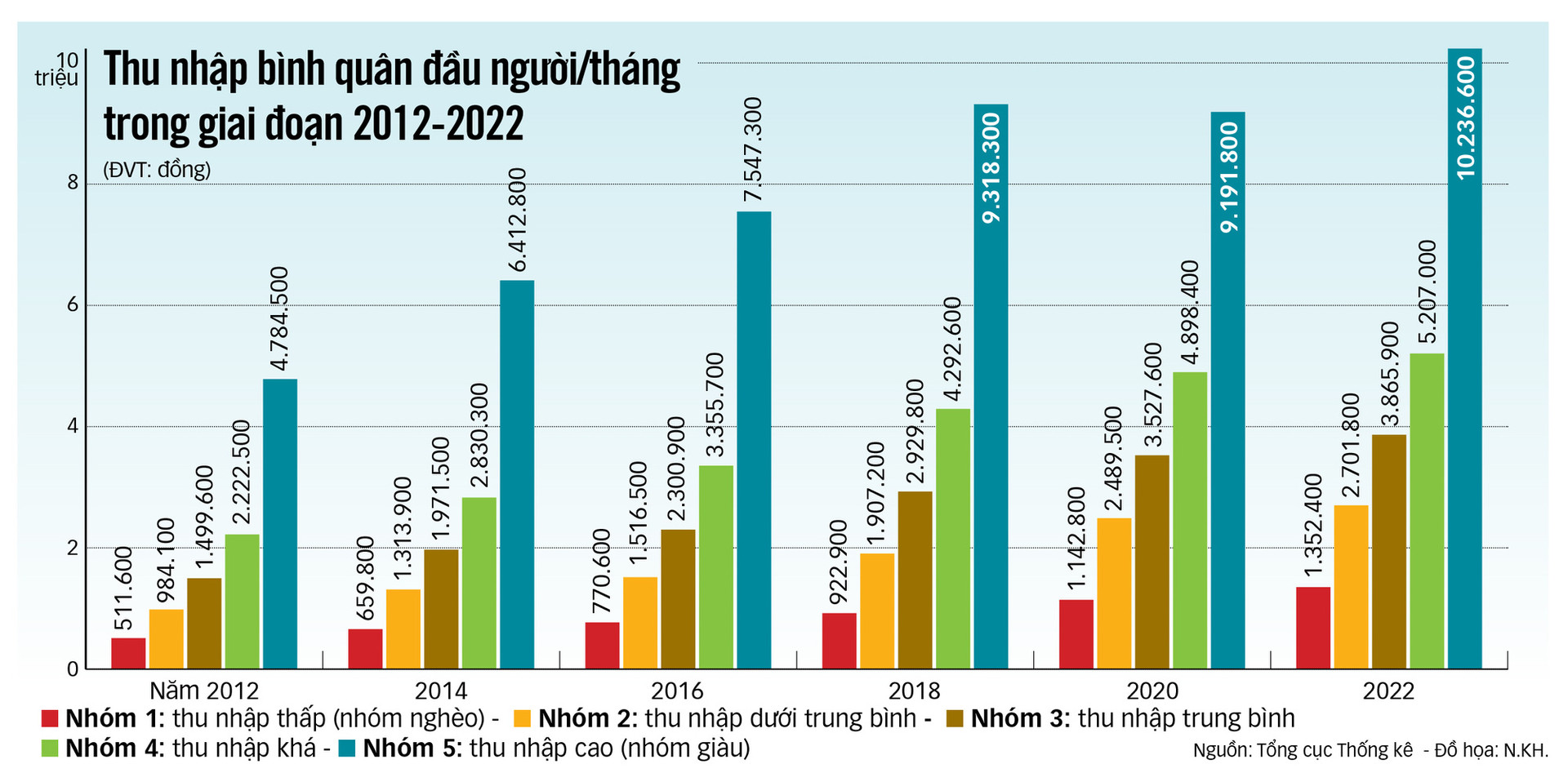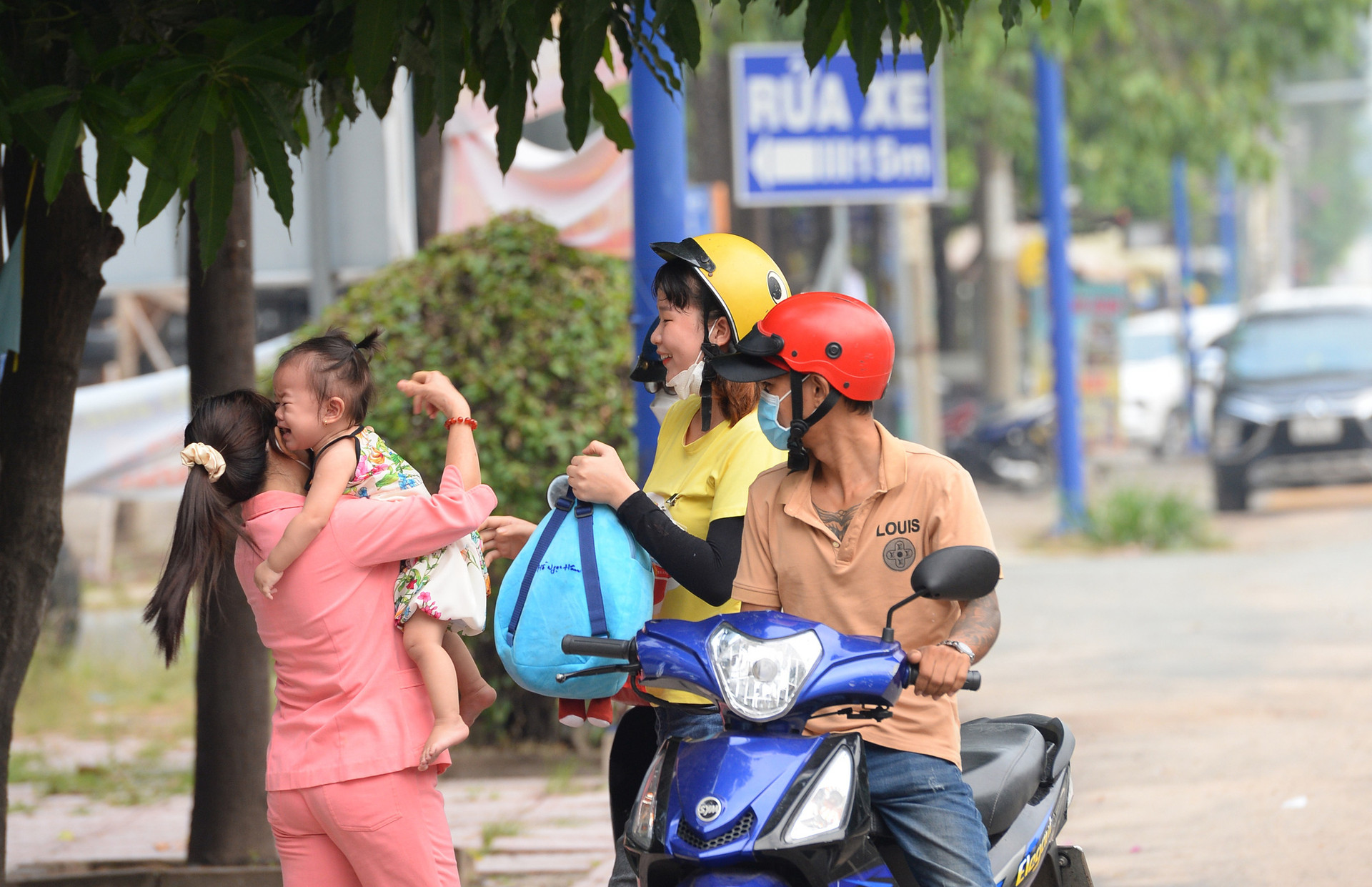The average income per capita nationwide in the 2012 - 2022 period increased more than 2.3 times, from 1.99 million VND/person/month to 4.67 million VND/person/month.

These are the figures announced by the General Statistics Office in the 2022 Vietnam Living Standards Survey report published in early April 2024. Ms. Pham Thi Quynh Loi, Director of the Department of Social and Environmental Statistics, General Statistics Office, shared more about the survey content, which is conducted every two years and is carried out in even-numbered years.
Specifically, in 2022, the average income of people nationwide will reach 4.67 million VND/month, an increase of 11.1% compared to 2021. Thus, the average income per capita of people nationwide will reach about 56 million VND/year. Of which, urban people have an income of about 5.95 million/month, people in rural areas have an income of about 3.86 million VND/month.
The average monthly income of people calculated by the General Statistics Office includes all amounts received from wages, salaries, income from self-production in the fields of industry, construction, agriculture, forestry, fishery, trade, services and other income.
Among the 63 provinces and cities in the country today, Binh Duong province is the locality with the highest per capita income in the country, reaching about 8.07 million VND/month. The two largest economic centers in the country are Hanoi with per capita income reaching 6.42 million VND/month, Ho Chi Minh City with 6.39 million VND/month.
According to a survey by the General Statistics Office, with the above average income per capita, people are spending an average of about 2.8 million VND/person/month. And with the average household population in 2022 being about 3.6 people/household, each household spends an average of about 10 million VND/month.
From surveys of people's living standards over the past years, the General Statistics Office believes that social inequality still exists between urban and rural areas, between low-income and poor groups and high-income and rich groups (see graphic).

Commenting on the results of the recently announced survey on the living standards of the population, economic expert Dinh Tuan Minh (Director of the Center for Market Solutions for Socio-Economic Issues) said that the average income per capita of the whole country reaching 4.67 million VND/month is reasonable. Mr. Minh further explained: this is not the average GDP per capita, so all profits transferred abroad, taxes, and asset depreciation must be excluded.
More specifically, with an income of 4.67 million VND/month, a family of four will have an income of about 18.6 million VND. This income is only earned by the couple, while the two young children who are still in school cannot generate income, Mr. Minh said.
Speaking to Tuoi Tre, Ms. Nguyen Thi Huong, General Director of the General Statistics Office, said that the average income per capita in the survey report on the living standards of the population includes dependents in the household, those who do not work, are unemployed or are not of working age. If we separate the average income of wage earners, it will be higher.
"The survey on living standards provides the average monthly income of all people across the country, including people in urban, rural, remote and isolated areas. The survey is conducted according to international standards, investigating people's income from all sources such as wages, labor wages, other legal sources such as renting out houses, selling groceries and other sources of income. In addition, income from property division, dividends and stocks are also included in people's income," said Ms. Huong.
Regarding the spending level of 2.8 million VND/person/month, Ms. Huong said that the annual survey report on the living standards of the population records expenses for food, clothing, housing, education, healthcare and durable household appliances related to daily life such as buying refrigerators, televisions, and cars. Meanwhile, in rural areas, many retirees do not have a need to spend much, they grow their own vegetables, raise their own chickens, and produce for self-sufficiency, so the survey cannot count them in monthly expenses.
Associate Professor Dr. Ngo Tri Long, former director of the Institute for Price Market Research (Ministry of Finance), also affirmed that this average spending level is normal, it accurately reflects the general living expenses of people across the country today. Because in addition to living expenses, everyone tends to save to accumulate and invest in other areas.
Meanwhile, Mr. Dinh Tuan Minh also said that the average spending of 2.8 million VND/person/month is quite realistic, because most rural residents do not have to pay rent every month, they only have to spend on basic expenses related to food, living, electricity, water. And with an average income per capita of about 4.67 million VND/month, spending 2.8 million VND is reasonable, the savings rate of 30 - 40% reflects quite closely the saving trend of Vietnamese people.
In addition, Dr. Nguyen Bich Lam, former General Director of the General Statistics Office, also said that in 2022, the economy will face many post-pandemic difficulties, people's incomes will decrease during the epidemic years, so they tend to cut spending, only spending on essential needs such as food, accommodation, education, medical treatment and cutting spending on culture, entertainment, travel...

To improve people's income in the coming years, Ms. Nguyen Thi Huong said that it is necessary to promote the development of domestic production because all revenue comes from production. The State needs to pay attention and create favorable conditions for production enterprises, and at the same time, there needs to be support policies to create purely Vietnamese branded products, conquer the world market, and create higher added value for Vietnamese people.
"The ultimate goal of economic growth is to create better income for people, thereby improving and raising people's living standards. This is a very important criterion because growth that does not benefit people and people's lives are not improved is not very meaningful," Ms. Huong emphasized.
Meanwhile, Mr. Nguyen Ba Hung, chief economist of ADB in Vietnam, said that the only way to increase people's income is to improve labor productivity in the economy. When labor productivity increases, wages and income of workers will increase accordingly.
In the current economy, the labor productivity of FDI enterprises is quite high, because this is a competitive sector with the world. FDI enterprises mainly export manufactured goods to the world, which means that compared to the world, this sector is competitive enough and labor productivity is not much lower than the world. Therefore, it can be affirmed that FDI enterprises have relatively good labor productivity.
As for domestic enterprises, labor productivity is still a difficult problem. Labor productivity of the domestic enterprise sector depends on two issues. First is the role of the Government in investing and developing modern infrastructure, because simply put, if there are many traffic jams, there cannot be high labor productivity. Therefore, from the Government's perspective, it is necessary to actively invest to create modern and synchronous infrastructure to support enterprises in improving labor productivity.
Second, from the business side, it is a capital-intensive issue. Investing in more machines/workers will increase labor productivity thanks to the process of replacing manual work with machines, higher precision, and reduced error and product failure rates. To do this, businesses must invest in technological lines and increase the capital/labor ratio. In addition, promoting digital transformation helps businesses manage more effectively, thereby improving labor productivity.
In addition, the Government needs to improve the business environment to reduce business costs and improve business performance. Many Vietnamese businesses do not want to increase their scale or become larger because business procedures are still too complicated. When the business environment is favorable, businesses can reduce business costs, improve performance, and increase labor productivity.
From surveys of people's living standards over the past years, the General Statistics Office believes that social inequality still exists between urban and rural areas, between low-income and poor groups and high-income and rich groups (see graphic).
General for all people
* Income: 4.67 million VND/person/month
* Expense: 2.8 million VND/person/month
Regarding the difference between GDP per capita and per capita income in 2022, Mr. Minh commented that for a country whose growth relies heavily on foreign direct investment (FDI) and exports, the growth that FDI investors enjoy will also be commensurate with the investment capital they put in.
Sharing this view, an economic expert also said that although the economy's GDP has increased rapidly in recent years, the average GDP per capita has reached about 95.6 million VND/year (about 4,110 USD/year), but the average import per capita is about 56 million VND/year, the difference of 39.6 million will basically belong to FDI investors, because in the current structure of Vietnam's GDP, there is a significant contribution from FDI investors.

When it comes to income and expenditure, it is probably the most "headache" issue for urban workers. They have a moderate salary but spend a lot of money on urban prices, especially rent. Their only "investment" is their children.
At 34 years old, Ms. Nguyen Thi Ngoc Lan (Hoc Mon, Ho Chi Minh City) has been working as a garment worker for 15 years with an income of 9 million VND/month. "The salary has doubled, tripled the income of more than ten years ago, but many things have followed. Rent has increased, electricity and water have increased, gasoline has increased, food and drinks have increased, clothes have increased... Life seems to be more difficult than before because of the birth of two children," Ms. Lan confided.
She roughly calculated the family's income and expenses: "The income of the couple is from 11 to 15 million/month if the company has overtime (her husband works in the warehouse so his salary is much lower - PV). The rent, electricity and water are about 2.5 million VND because she rented a house with her sister who is raising a small child to save money. The two children's daycare and school expenses are about 4 million VND.
The remaining money is used to pay for gas, breakfast, and dinner. For two meals a day, breakfast or dinner, a family of four can only afford about 200,000 VND. And when there are unexpected expenses, illness, or the child needs to pay for a picnic... then the food budget has to be cut down, and the whole family has to accept eating frugally."
Last year, when her husband broke his leg and had to take nearly two months off work, to have money to take care of him and their children, Lan had to borrow 22 million VND from CEP (a microfinance organization that lends small loans to workers at low interest rates) and pay back about 1.9 million VND each month.
For Mr. Nguyen Van Son (35 years old, living in Tan Phu district), a construction worker, his income has taken a "quantum leap" when it increased from 6 - 7 million in 2017 to 18 - 19 million VND/month currently (he used to work for a company, then worked freelance in a team). His wife graduated from university but now has to stay home to raise two young children who were born one after another. Although his current salary has tripled, it is still the family's only source of income.
"The construction industry is unstable. I work on individual houses, so my salary is 18-19 million VND/month, but every year there are 2-3 months without any construction work." Son's family's expenses include: rent, electricity, water, and Internet, about 5 million VND/month.
Tuition and English classes for his two daughters, who are in grades 3 and 5, are about 4 million VND (after deducting the boarding meals that his wife cooks and takes home). The remaining expenses for food for four people, clothes, gas for work, picking up and dropping off the children, parties... are all in the 7-8 million VND range.
"My salary is increasing but my children are growing up every day, so my expenses are increasing. My wife and I have to rent a house, but now we have to save money to make ends meet, so what can we expect from a house? I just hope to have good health to take care of my children's education," said Mr. Son.
10 provinces with the highest income in the country:Hanoi: 6.42 million VND, Vinh Phuc: 5.19 million VND, Bac Ninh: 5.46 million VND, Hai Phong: 5.89 million VND, Nam Dinh: 5.1 million VND, Da Nang: 5.8 million VND, Binh Duong: 8.07 million VND, Dong Nai: 6.34 million VND, Ho Chi Minh City: 6.39 million VND, Can Tho: 5.32 million VND.
10 lowest provinces in the country:Ha Giang: 2.06 million VND, Cao Bang: 2.35 million VND, Bac Kan: 2.34 million VND, Dien Bien: 2.08 million VND, Lai Chau: 2.21 million VND, Son La: 2.14 million VND, Gia Lai: 2.56 million VND, Lao Cai: 2.88 million VND, Yen Bai: 2.84 million VND, Lang Son: 2.7 million VND.